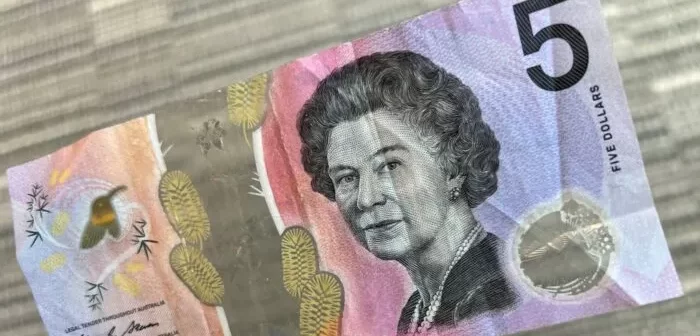The late Queen Elizabeth II will not be featured on Australia’s five-dollar note going forward, instead, a new design that “honours the culture and history of the First Australians”—a term to refer to Aboriginal Australians—will replace the monarch.
The country’s five-dollar bill has featured the late Queen since 1992 and was due to be replaced with her son, King Charles III.
Yet on Feb. 2, the Reserve Bank of Australia announced the swap.
“The Reserve Bank has decided to update the $5 banknote to feature a new design that honours the culture and history of the First Australians. This new design will replace the portrait of Her Majesty Queen Elizabeth II. The other side of the [five-dollar] banknote will continue to feature the Australian Parliament,” the Bank said in a statement.
“This decision by the Reserve Bank Board follows consultation with the Australian Government, which supports this change.”
The Bank would consult with representatives of Indigenous Australians, noting that the new design would take “a number of years” to be finalised and printed.
The current 50-dollar bill already features famous Indigenous man David Uniapon, an author, activist, musician, and preacher.
While the five-dollar note also includes the Forecourt Mosaic, which is based on a Central Desert dot-style painting by Michael Nelson Jagamara.
The face of King Charles III is expected to be seen on Australian coins later this year.
Treasurer Backs Decision, Opposition Calls It ‘Woke Nonsense’
Labor Treasurer Jim Chalmers has backed the move calling it an “opportunity to strike a good balance.”
“The monarch will still be on the coins, but the $5 note will say more about our history and our heritage and our country, and I see that as a good thing,” he said.
However, federal opposition leader Peter Dutton said the move aligned with calls to change the date of Australia Day.
“I know the silent majority don’t agree with a lot of the woke nonsense that goes on, but we’ve got to hear more from those people online,” he told 2GB Radio on Feb. 2.
He claimed Prime Minister Anthony Albanese was “central” to the decision and pushed the leader to be upfront about it.
“If it’s a decision they’ve made, own it, just be responsible and put your hand up and say this is the reason we’ve made it,” he said.
“It’s an attack on the national anthem, the flag, the name of Australia as we’re seeing in other parts of the world. So, I just think you’ve got to stand up and a lot more Australians have to be heard.”
Wokeism Starting to Take Hold Down Under
The Reserve Bank’s decision comes after several major Australian companies, and local councils opted out of celebrating the country’s national day, saying it should be a “day of mourning.”
January 26 is the day Captain Arthur Phillip’s First Fleet arrived in Sydney Cove (now known as Circular Quay) and established the first European settlement in Australia; for years, it has been celebrated as the beginning of the country.
Firms that have done this include retail giant Kmart, supermarket chain Woolworths, Australia’s largest telecommunications firm Telstra, Deloitte, KPMG, Ernst and Young, and CBS-owned Channel 10.
One tool to advance cancel culture is to be “woke” or embrace social justice causes like offering greater recognition of Indigenous rights.
Yet such a move often comes at the expense of the traditions of a country, a situation similar to the violent communist movements of China, Russia, and Cambodia, according to senior fellow at the Discovery Institute Scott Powell.
Source: The Epoch Times

